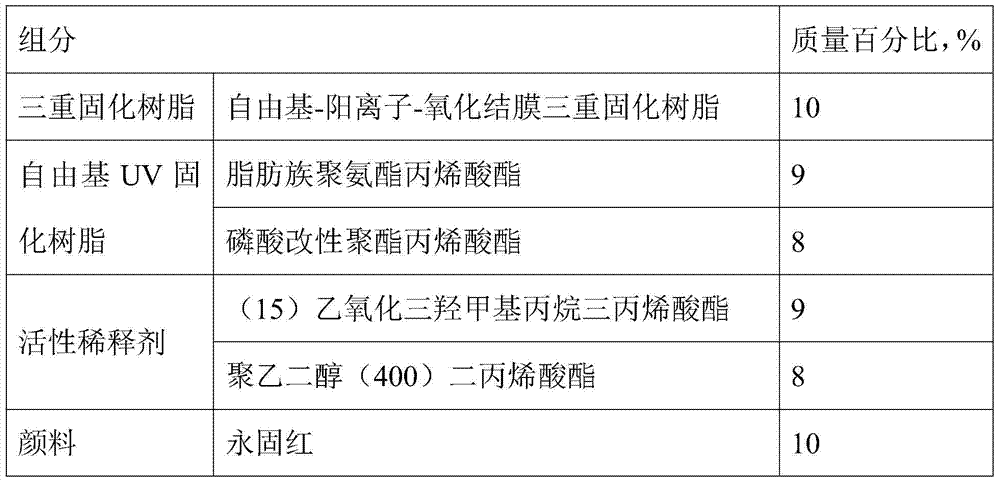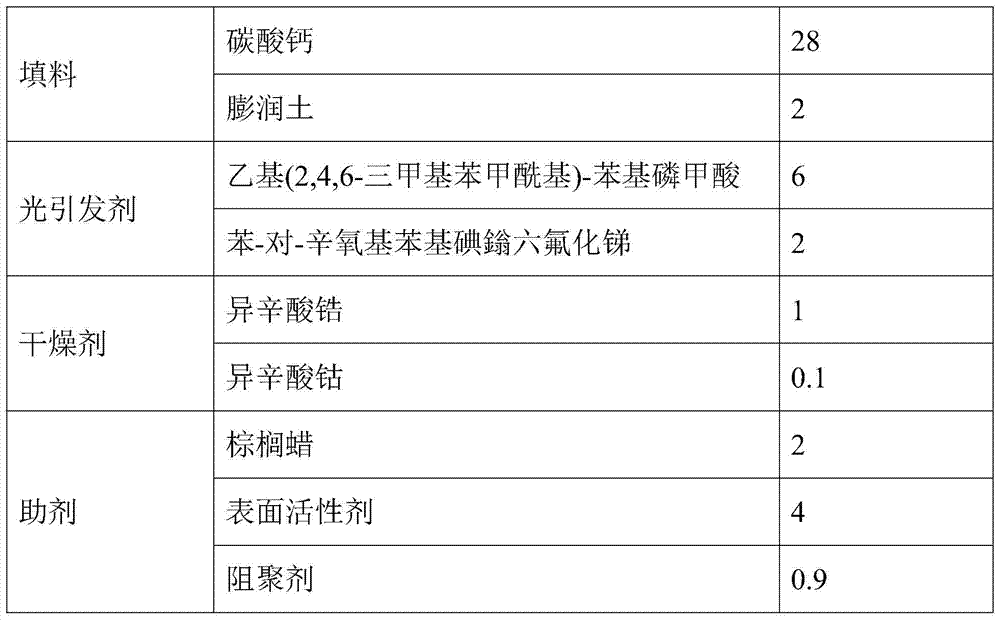Radical‑Cation‑Oxidative Conjunctival Triple Cure Engraving Gravure Ink
A technology of oxidized conjunctiva and triple curing, applied in inks, household utensils, applications, etc., can solve problems such as poor tolerance and poor compatibility between components, and achieve the effect of increasing curing depth and shortening the reprinting cycle
- Summary
- Abstract
- Description
- Claims
- Application Information
AI Technical Summary
Problems solved by technology
Method used
Image
Examples
Embodiment 1
[0043] Preparation of Example 1 Free Radical-Cation-Oxidation Conjunctiva Triple Curing Resin (1)
[0044] (1) In a 500ml four-necked flask, add 200g of bis(3,4-epoxycyclohexylmethyl)adipate and 4-methoxyphenol accounting for 1% of epoxy resin mass, and heat to 50°C , the metered linolenic acid (the molar ratio of epoxy resin to linolenic acid is 1:0.5) is added dropwise into the epoxy resin, and the dropping time is 2 hours. The linolenic acid is added with 0.3% tetrabutylene, which accounts for 0.3% of the mass of the epoxy resin. ammonium bromide;
[0045] After the addition of linolenic acid is complete, control the reaction system at 60°C and react for 1 hour to obtain a bifunctional epoxy prepolymer with an epoxy group at one end and an unsaturated fatty acid double bond at the other end;
[0046] (2) the above-mentioned synthetic bifunctional epoxy prepolymer is dissolved in methylene chloride, adding triethylamine accounting for 0.1% of the bifunctional epoxy prepolym...
Embodiment 2
[0049] Preparation of Example 2 Free Radical-Cation-Oxidation Conjunctiva Triple Curing Resin (2)
[0050] (1) In a 500ml four-necked flask, add 200g of 3,4-epoxycyclohexyl carboxylate and 4-methoxyphenol accounting for 1% of the epoxy resin quality, heat to 60°C, and the metered oleic acid (The molar ratio of epoxy resin and oleic acid is 1:0.6) was added dropwise in the epoxy resin for 3 hours, and tetrabutylammonium bromide accounting for 0.3% of the mass of the epoxy resin was added to the oleic acid;
[0051] After the oleic acid is added dropwise, control the reaction system at 70°C and react for 2 hours to obtain a bifunctional epoxy prepolymer with an epoxy group at one end and an unsaturated fatty acid conjugated double bond at the other end;
[0052] (2) the bifunctional epoxy prepolymer of above-mentioned synthesis is dissolved in methylene chloride, adds and accounts for the triethylamine of 0.3% of bifunctional epoxy prepolymer quality; Slowly add the acryloyl chl...
Embodiment 3
[0054] Example 3 Preparation of Free Radical-Cation-Oxidation Conjunctiva Triple Curing Resin (3)
[0055] (1) In a 1000ml four-necked flask, add 500g of bis(3,4-epoxycyclohexylmethyl)adipate and 4-methoxyphenol accounting for 3% of epoxy resin mass, and heat to 80°C , the metered linolenic acid (the molar ratio of epoxy resin and linolenic acid is 1:1) is added dropwise in the epoxy resin, and the dropping time is 4 hours, and 0.5% tetrabutylene, which accounts for 0.5% of the mass of the epoxy resin, is added in the linolenic acid ammonium bromide;
[0056] After the addition of linolenic acid is complete, control the reaction system at 100°C and react for 3 hours to obtain a bifunctional epoxy prepolymer with an epoxy group at one end and an unsaturated fatty acid double bond at the other end;
[0057] (2) the bifunctional epoxy prepolymer of above-mentioned synthesis is dissolved in methylene chloride, adds and accounts for the triethylamine of 0.5% of bifunctional epoxy ...
PUM
 Login to View More
Login to View More Abstract
Description
Claims
Application Information
 Login to View More
Login to View More - R&D
- Intellectual Property
- Life Sciences
- Materials
- Tech Scout
- Unparalleled Data Quality
- Higher Quality Content
- 60% Fewer Hallucinations
Browse by: Latest US Patents, China's latest patents, Technical Efficacy Thesaurus, Application Domain, Technology Topic, Popular Technical Reports.
© 2025 PatSnap. All rights reserved.Legal|Privacy policy|Modern Slavery Act Transparency Statement|Sitemap|About US| Contact US: help@patsnap.com



